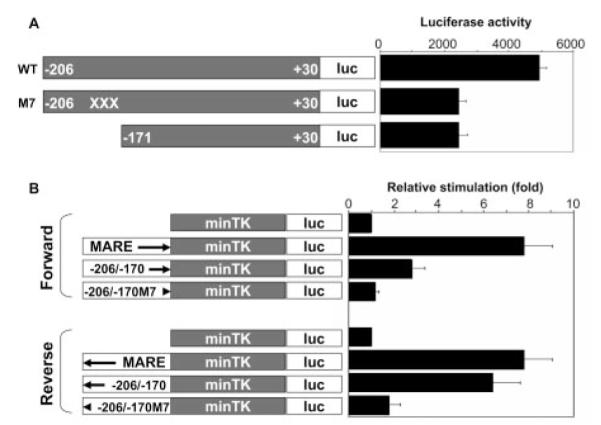FIGURE 6.

Enhancer activity of the MARE-like sequence. A, RAW264.7 cells were cotransfected with pIL-10(−206/+30)-luc, pIL-10(−206/+30)M4-luc, or pIL-10(−171/+30)-luc with the c-Maf expression vector (reporter:effector is 1:1/4 in molarity). The crosses in the M4 construct denote the 13-bp mutations. Statistic analysis indicates that, compared with pIL-10(−206/+30)-luc, pIL-10 (−206/+30)M4-luc significantly lost its response to c-Maf induction (p < 0.001) and decreased to the level comparable with the downstream deletion mutant reporter pIL-10(−171/+30)-luc (p > 0.05). Mean values ± SD of three experiments are shown. B, The sequences of −206/−170, −206/−171M4 (mutant), and MARE consensus were cloned into a minimal TK promoter in both orientations (forward and reverse indicated by directional arrows). RAW264.7 cells were cotransfected with these chimeric reporter constructs or the parental pTK-luc, with c-Maf expression vector (reporter:effector = 1:1/4 in molarity). Luciferase activity was expressed as relative stimulation to that of the minimal pTK-luc reporter, which is arbitrarily set as 1. Compared with the minimal pTK-luc reporter, c-Maf significantly induced the response of p(MARE)-TK-luc and p(−206/−170)-TK-luc (p < 0.01 and p < 0.05, respectively) in both forward and reverse orientations; however, p(−206/−170)M4-TK-luc lost its response to c-Maf induction in both orientations (p > 0.05 and p > 0.05, respectively). Mean values ± SD of three experiments are shown.
